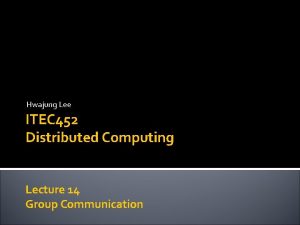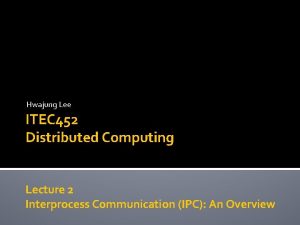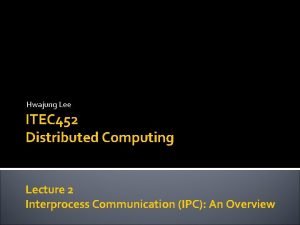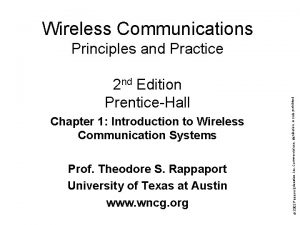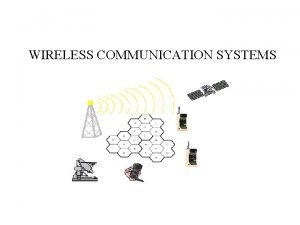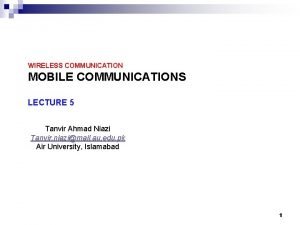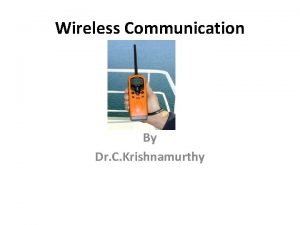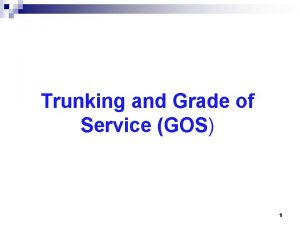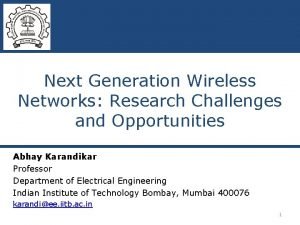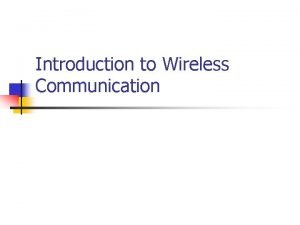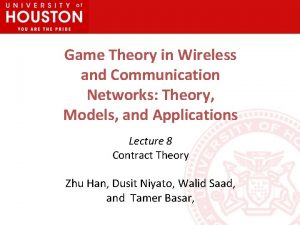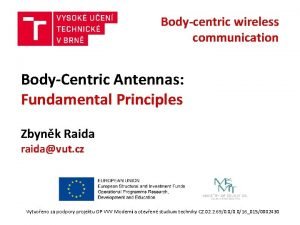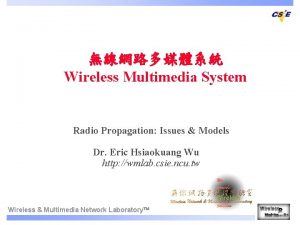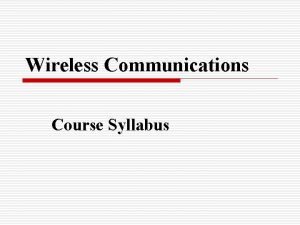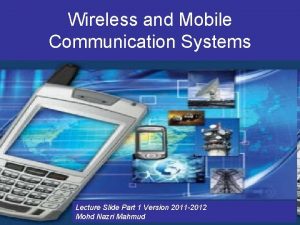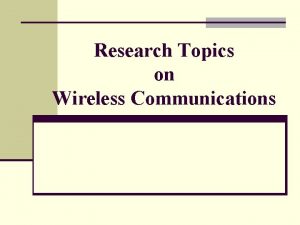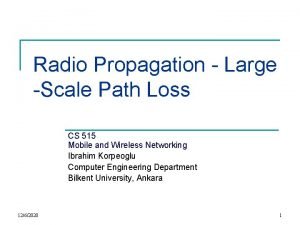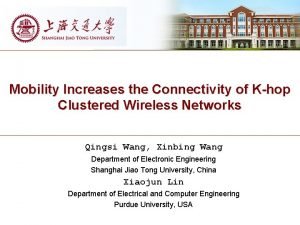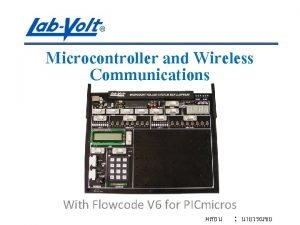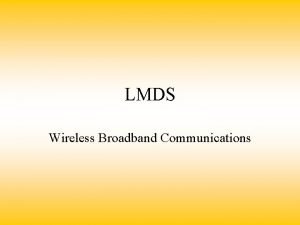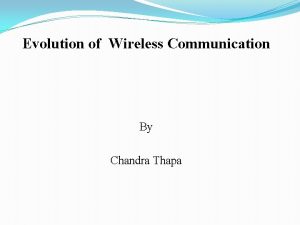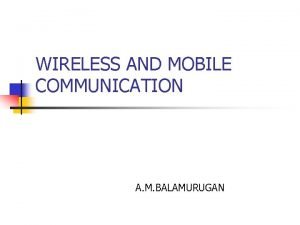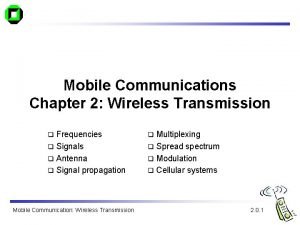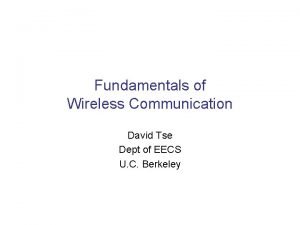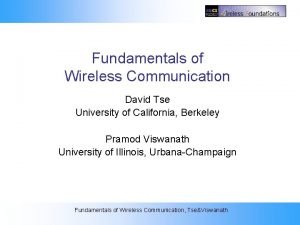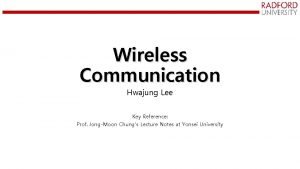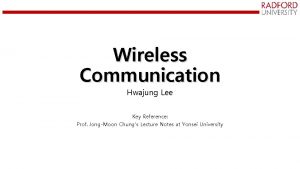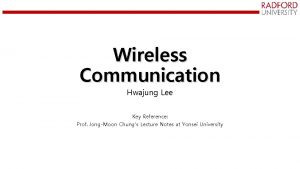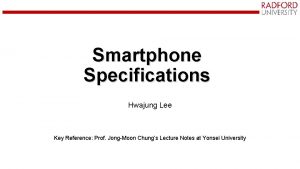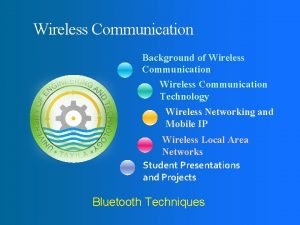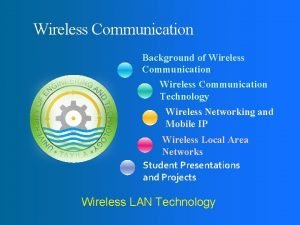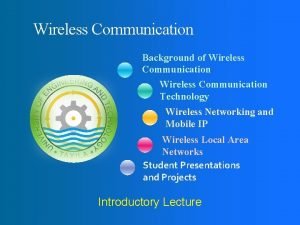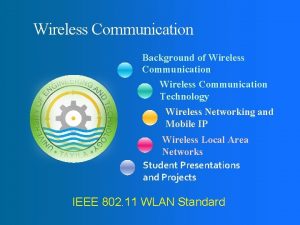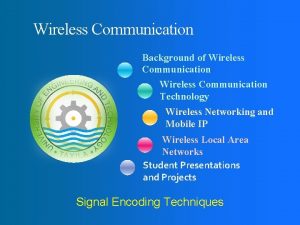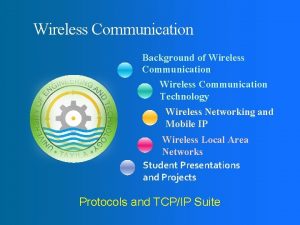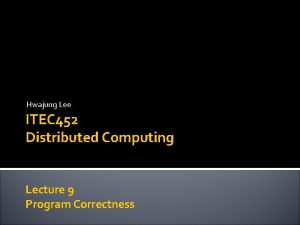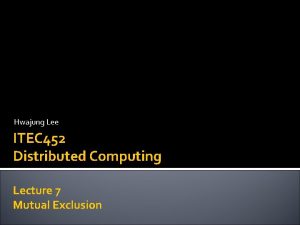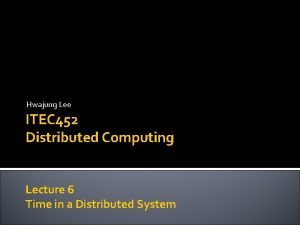Wireless Communication Hwajung Lee Key Reference Prof JongMoon





























- Slides: 29

Wireless Communication Hwajung Lee Key Reference: Prof. Jong-Moon Chung’s Lecture Notes at Yonsei University

Wireless Communications • Bluetooth • Wi-Fi • Mobile Communications • LTE-Advanced

Wi-Fi WLAN • WLAN (Wireless Local Area Network) is a wireless networking technology that links two or more computing devices using a wireless distribution method within a limited local area • Applications Areas: Home, School, Computer Laboratory, Office Building, etc.

Wi-Fi • Wi-Fi (or Wi. Fi) is a WLAN technology that allows electronic devices to network mainly using the ISM radio bands • 2. 4 GHz UHF (Ultra High Frequency) • 5 GHz SHF (Super High Frequency)

Wi-Fi Transmission • 5 GHz offers higher throughput at shorter distances • 2. 4 GHz provides increased coverage and improved solid object penetration • Beamforming and other multiple antenna technologies like MIMO are used to increase the date rate and Qo. S

Wi-Fi Wireless AP (Access Point) • A device that allows Wi-Fi devices to connect to a wired network • AP usually connects to a router or may have built in router capabilities

Wi-Fi Example of an AP network

Wi-Fi Infrastructure Mode • In infrastructure mode, Wi-Fi devices can • communicate with each other and • communicate with a wired network • BSS (Basic Service Set) • In infrastructure mode, commonly one AP is connected by wire to the Internet, and a set of Wi-Fi devices connect to the AP

Wi-Fi Example of Infrastructure mode

Wi-Fi Ad-Hoc Mode • Wi-Fi devices or stations communicate directly with each other, without help from an AP (Access Point) Used where Infrastructure Mode network setup is not needed or not possible • Also referred to as peer-to-peer mode • IBSS (Independent Basic Service Set) • Ad-hoc mode network is referred to as an IBSS

Wi-Fi Example of Ad-Hoc mode

Wi-Fi BSS & ESS • BSS (Basic Service Set) is the basic building block of an 802. 11 WLAN • In infrastructure mode, a BSS is formed by a single AP (Access Point) and all associated STAs (stations) • AP acts as a Master and controls all STAs within the BSS • ESS (Extended Service Set) is a set of two or more BSSs that form a single network Extends the range of Wi-Fi STA mobility

Wi-Fi Example of ESS

Wi-Fi IEEE 802. 11 Network PHY Standards (1/2) 802. 11 Protocol Release Date Frequency Bandwidth 802. 11 -1997 Jun. 1997 2. 4 GHz 22 MHz 1, 2 Mbps Sep. 1999 5 GHz 20 MHz 6 ~ 54 Mbps 802. 11 a Stream Data Rate 3. 7 GHz 802. 11 b Sep. 1999 2. 4 GHz 22 MHz 1 ~ 11 Mbps 802. 11 g Jun. 2003 2. 4 GHz 20 MHz 6 ~ 54 Mbps 802. 11 n Oct. 2009 2. 4/5 GHz 20 MHz 7. 2 ~ 72. 2 Mbps 40 MHz 15 ~ 150 Mbps

Wi-Fi IEEE 802. 11 Network PHY Standards (2/2) 802. 11 Protocol Release Date Frequency Bandwidth Stream Data Rate 802. 11 ac Dec. 2013 5 GHz 20 MHz 7. 2 ~ 96. 3 Mbps 40 MHz 15 ~ 200 Mbps 80 MHz 32. 5 ~ 433. 3 Mbps 160 MHz 65 ~ 866. 7 Mbps Up to 7 Gbps 802. 11 ad 2012, 2016 60 GHz 2. 16 GHz 802. 11 ay 2017 60 GHz 8 GHz Up to 100 Gbps

Wi-Fi IEEE 802. 11 Network PHY Standards (1/2) 802. 11 protocol Frequency Modulation Approximate Range Indoor (m) Outdoor (m) 802. 11 -1997 2. 4 GHz DSSS, FHSS 20 100 802. 11 a 5 GHz OFDM 35 120 - 5000 3. 7 GHz 802. 11 b 2. 4 GHz DSSS 35 140 802. 11 g 2. 4 GHz OFDM, DSSS 38 140

Wi-Fi IEEE 802. 11 Network PHY Standards (2/2) 802. 11 protocol Frequency Modulation Approximate Range Indoor (m) Outdoor (m) 802. 11 n 2. 4/5 GHz OFDM (MIMO-4)* 70 250 802. 11 ac 5 GHz OFDM (MIMO-8)* 35 - 802. 11 ad 60 GHz OFDM (> 10 X 10 MIMO) 10 10 *MIMO-4 and MIMO-8 represent that the allowable MIMO streams are 4 and 8, respectively.

Wi-Fi uses the ISM Band • ISM (Industrial, Scientific and Medical) bands are radio frequency bands reserved internationally for the use of industrial, scientific, and medical purposes • Devices using ISM bands will experience interference from other products operating in the same frequency band

Wi-Fi ISM Band Frequency range Bandwidth Center Frequency Availability 6. 765 MHz 6. 795 MHz 30 k. Hz 6. 780 MHz Subject to local acceptance 13. 553 MHz 13. 567 MHz 14 k. Hz 13. 560 MHz Worldwide 26. 957 MHz 27. 283 MHz 326 k. Hz 27. 120 MHz Worldwide 40. 660 MHz 40. 700 MHz 40 k. Hz 40. 680 MHz Worldwide 433. 050 MHz 434. 790 MHz 1. 74 MHz 433. 920 MHz local acceptance 902. 000 MHz 928. 000 MHz 26 MHz 915. 000 MHz 2. 400 GHz 2. 500 GHz 100 MHz 2. 450 GHz local acceptance Worldwide

Wi-Fi ISM Band Frequency range Bandwidth Center Frequency Availability 5. 725 GHz 5. 875 GHz 150 MHz 5. 800 GHz Worldwide 24. 000 GHz 24. 250 GHz 250 MHz 24. 125 GHz Worldwide 61. 000 GHz 61. 500 GHz 500 MHz 61. 250 GHz Subject to local acceptance 122. 000 GHz 123. 000 GHz 122. 500 GHz Subject to local acceptance 244. 000 GHz 246. 000 GHz 245. 000 GHz Subject to local acceptance

Wi-Fi Interference • Devices operating in the 2. 4 GHz range include • IEEE 802. 15. 4 devices: Zig. Bee, 6 Lo. WPAN • Microwave ovens • Bluetooth • Baby monitors • Cordless telephones • Amateur radio equipment • etc.

Wi-Fi Dual Band • Unlike ordinary Wi-Fi equipment that only supports one signal band, dual band is the capability to transmit on the 5 GHz band of 802. 11 a, 802. 11 n, and 802. 11 ac and also the 2. 4 GHz band used by 802. 11 b, 802. 11 g, and 802. 11 n

Wi-Fi Example of Dual Band

Wi-Fi Direct • Wi-Fi Direct devices can connect directly to one another without access to a traditional network • Devices can make a one-to-one connection, or a group of several devices can connect simultaneously

Wi-Fi Direct • With optional services, users can send files, print documents, play media, and display screens between and among devices

Wi-Fi Tethering (Hotspot) • Tethering refers to connecting one device to another • In the context of mobile phones or Internet tablets, tethering allows sharing the Internet connection of the phone or tablet with other devices such as laptops

Wi-Fi Tethering (Hotspot) • A Wi-Fi STA can make connection to the Internet by connecting to a smartphone using Wi-Fi

References • M. Gast, 802. 1 wireless networks: the definitive guide. O'Reilly Media, 2005. • B. P. Crow, I. Widjaja, J. G. Kim, and P. T. Sakai, “IEEE 802. 11 Wireless Local Area Networks, ” IEEE Communication Magazine, vol. 35, no. 9, pp. 116 -126, Sep. 1997. • E. Ferro and F. Potorti, “Bluetooth and Wi-Fi wireless protocols: a survey and a comparison, ” IEEE Wireless Communications, vol. 12, no. 1, pp. 12 -26, Feb. 2005. • Webopedia, Extended Service Set, http: //www. webopedia. com/TERM/E/Extended_Service_Set. html [Accessed June 1, 2015] • Speedguide, Wi-Fi 5 GHz vs 2. 4 GHz, http: //www. speedguide. net/faq/is-5 ghz- wirelessbetter-than-24 ghz-340 [Accessed June 1, 2015] • Wi-Fi Alliance, http: //www. wi-fi. org • Wikipedia, http: //www. wikipedia. org • William Stallings, Data and Computer Communications, 10 th Ed. Prentice Hall, 2014.

References Image sources • Wi-Fi Icon, By Canopus 49 (Own work) [CC BY-SA 3. 0 (http: //creativecommons. org/licenses/by-sa/3. 0)], via Wikimedia Commons • USB, By TEL 0000 (Own work) [Public domain], via Wikimedia Commons • PCI, By Evan-Amos (Own work) [Public domain], via Wikimedia Commons • Laptop PC Icon, By Everaldo Coelho (Yellow. Icon) [LGPL (http: //www. gnu. org/licenses/lgpl. html)], via Wikimedia Commons
 Hwajung
Hwajung Hwajeong
Hwajeong Hwajung
Hwajung What are wireless devices and the wireless revolution
What are wireless devices and the wireless revolution Reference node and non reference node
Reference node and non reference node Reference node and non reference node
Reference node and non reference node Wireless communication introduction
Wireless communication introduction Mobile communication
Mobile communication Cell dragging in wireless communication
Cell dragging in wireless communication Advantages of wireless transmission
Advantages of wireless transmission What is trunking and grade of service
What is trunking and grade of service Global next generation wireless communication market
Global next generation wireless communication market Disadvantage of wireless communication
Disadvantage of wireless communication Game theory in wireless and communication networks
Game theory in wireless and communication networks Stanford wireless communication
Stanford wireless communication Cdpd provides low cost wireless data services to
Cdpd provides low cost wireless data services to Fundamental principles of wireless communication
Fundamental principles of wireless communication Free space propagation model in wireless communication
Free space propagation model in wireless communication Wireless communication course syllabus
Wireless communication course syllabus Large scale fading in wireless communication
Large scale fading in wireless communication Wireless communication research topics
Wireless communication research topics Friis free space propagation model
Friis free space propagation model Free space propagation model in wireless communication
Free space propagation model in wireless communication Microcontroller wireless communication
Microcontroller wireless communication Lmds in wireless communication
Lmds in wireless communication Evolution of wireless communication
Evolution of wireless communication Mobile communication syllabus
Mobile communication syllabus Wireless communication
Wireless communication David tse wireless communications
David tse wireless communications Fundamental of wireless communication
Fundamental of wireless communication
